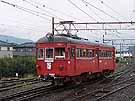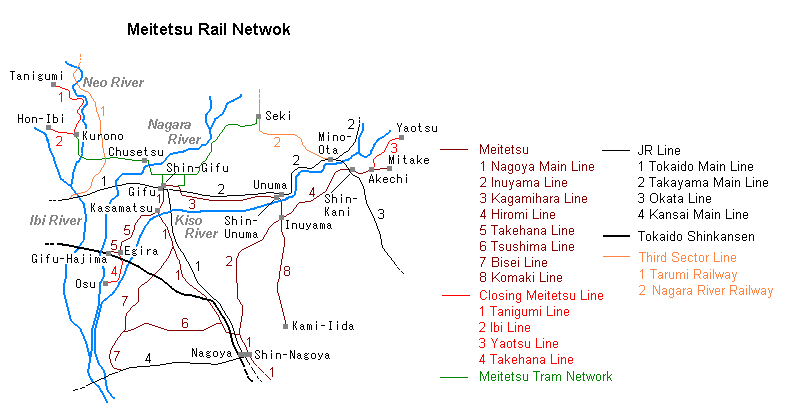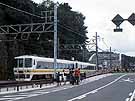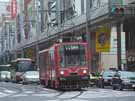
Leaving Kurono is a 1929-built vintage EMU numbered 751 on its last work with the service closure close at hand.
Page 1

Leaving Kurono is a 1929-built vintage EMU numbered 751 on its last work with the service closure close at hand. |
We hopped onto a
limited express bound for Shin-Unuma along the
Inuyama Line. Thanks to Anthony, we could get seats at the front most
or rear most position on the Super Panorama Car. The journey to
Shin-Unuma was swift enough with only a 30 minutes ride, but we enjoyed
superb front or rear views from the upper level on the Panorama Car.
Crossing the Kiso River by a great truss bridge, we pulled into
Shin-Unuma station. Until quite recently, the bridge was also a road
bridge, and trains used to cross it by street trackage, but now it has
turned to dedicated use for Meitetsu trains.


Slowly passing by us was a sleek DMU of type 8500, the Meitetsu version of the JR Kiha 85, on the through 'Kita-Alps' service, leaving the bridge crossing the great Kiso River. |
Along Kagamihara Line:
Our next journey was as far as Shin-Gifu along the Kagamihara Line by a
local. We sat in longitude style seats for a trip of about 30 minutes.
The Kagamihara Line runs westwards with the view of the paralle JR
Takayama Main Line in the north. The area the Line covers is mostly
over Kagamihara city, a satellite city of Gifu, prefectural capital.
The great Kiso River is about 1 km south, flowing westwards. Lying
south of the river are a number of small cities and towns surrounding
Nagoya's urban area. Being so situated, the scenery outside the windows
was half suburban and half rustic. The weather was not very favorable
under a half overcast sky with thin sunlight. Nearing Gifu, turning to
the north, our train went up onto a viaduct to cross over the Takayama
Main Line, and then ran down to Gifu's city area. At the approach to
Shin-Gifu station, the line was joined by rails coming from the street
running Gifu city tram line. This rail link allows the trams to reach
Shin-Gifu terminus, featuring unique tram and heavy rail through
operation. Soon, we arrived at Shin-Gifu terminus on the ground level.
We were impressed with the station's special structure assigning one
track to tram cars in dedicated use. The adjoining elevated track with
Meitetsu's Nagoya Main Line's Shin-Gifu terminus reached from the south
crossing over the JR Tokaido Main Line. Shin-Gifu gave us a feeling of
a great strategic rail terminus.

Gifu is still a tram-oriented city with Meitetsu's light rail network. On the street in front of Shin-Gifu station. |
From the tram stop,
we rode an express tram for Kurono, today's our
main destination: where the endangered Meitetsu Tanigumi Line
originates. The tram was well loaded with many standing passengers.
Rambling along a street, our tram went up to the north for a while, and
then took a sharp curve to the west at Tetsumeicho intersection, the
Gifu's busiest quarter. After passing some stops and changing direction
to the north again, we crossed the Nagara River by a fantastic truss
road bridge. After a ride of 20 minutes at Chusetsu, the street running
ended, and we entered the Ibi Line section. The remaining of about 12
km for Kurono was in an interurban ambience, with suburban scenery
outside the windows, but half mixed with rural landscapes. The run was
quite smooth along the dedicated track with increased speed. The sky
darkened, and it finally started raining. One station passed had a
strange, but difficult name in reading, Shikke, meaning arse-hair. We
arrived in Kurono in drizzling rain.
The round trip to
Tanigumi on the vintage EMU was quite nice, with
the dear sounds of nose-suspended traction motors all the way. After
Kurono, suburban scenery continued for a while, but soon it turned
mountainous. On the right, the Neo River came close beyond the
paralleling road, but just left to us was the edge of a forested
mountain. Our route was along the snaking Neo River for a while through
a rustic landscape. Stations passed on the way were all unattended,
except an interlocking loop, where a train in the opposite direction
was met. The train was a two-car set of vintage types 750 in their red
livery. Tokens were exchanged between our driver and a station employee
for the final run towards Kurono. Once out of the loop, the Neo River
was gone to the north, and passing through a squeezed passage between
flanks of the mountains, we emerged onto a plateau where was a stretch
of rice fields, with farmhouses scattered here and there. Running along
the rather flat land for a while and passing through woods along the
foot of a gently rising mountain, we arrived at Tanigumi, where our
train was welcomed by a number of photographers on the platform. On our
return trip, congestion was worse with passengers packed like in a rush
hour train in Tokyo.
Returning to
Kurono, we made another return trip to Hon-Ibi by
single unit of #751. Although it was a trip on a longitude style seats,
riding another type of a vintage electric car was nice. Unlike the
Tanigumi Line, the Kurono to Hon-Ibi section was much shorter with only
two intermediate stations. Its ambience was half rustic on flat
terrain. Thus, we finished our main activities on that day, and rode
back to Shin-Gifu by a tram to return to Shin-Nagoya via the Nagoya
Main Line.